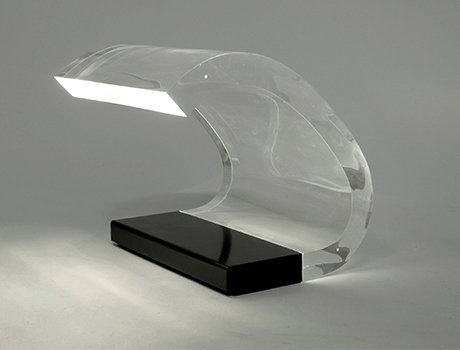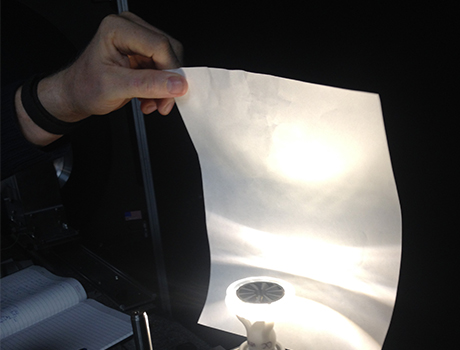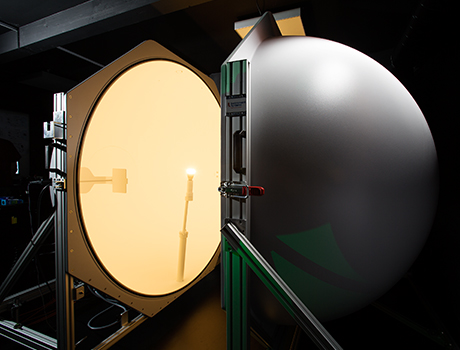PH lamps and other design icons will now be producing light similar to that of the classic incandescent bulb. A group of researchers, lighting experts, designers, and engineers are currently in the process of developing a new, energy-saving LED light bulb featuring custom-made optics.
Next year, connoisseurs will have the perfect lighting for their iconic lamps, when the traditional light bulb—or rather light source, to use the term preferred by experts—in the classic PH lamps, including PH 5 and PH Artichoke, can be replaced by a new LED light source which ensures optimal spreading of the light across the lamp shades, thereby creating a beautiful aesthetic experience.
The new light source, which has been named CooLED, does not produce the traditional spotlight or omnidirectional light characterizing standard light sources. Instead, each lamp will be fitted with a light source with a light profile optimized for the lamp design.
The project—funded through the Danish Energy Agency's EUDP programme—was initiated by DTU Fotonik, AT Lighting, Louis Poulsen, Noliac, CB Svendsen, and the Danish Technological Institute.
PH lamp without light loss
"The future looks bright for the CooLED light source. It stands out due to its custom-made optics solution capable of illuminating a PH lamp with minimal light loss, which is exactly what Poul Henningsen had in mind when designing the lamp," says Jacob Willer Tryde, CEO at Lighting ApS.
The idea for CooLED was born during summer 2008 when Alexandra Alexiou, partner at Lighting, found inspiration in the 'Colombo 281' lamp designed by the Italian industrial designer Joe Colombo. A light source is hidden in the lamp base, transmitting the light up through the lamp's beautiful curvy shape made from transparent, light-conducting acrylic.
The ideas were further developed in the final project at the Danish Design School, which Alexandra Alexiou and Jacob Willer Tryde were working on together. The aim was to create a worthy LED successor to the American inventor Thomas Edison's classic incandescent bulb.
|
The inspiration for the new light source was found in the 'Colombo of 281' lamp, where the light source is hidden in the lamp base, transmitting the light up through the transparent acrylic.
Photo: Oluce
|
|
 |
Works like a chimney
The light source in CooLED consists of a basic light source with a series of diodes and a lens. The lens is custom-made for a specific lamp and either focuses or diffuses the light, depending on the lamp in which it is fitted. This produces better lighting as well as energy savings, as light loss is reduced to a minimum.
The LED light source is based on an innovative solution involving cooling of the diodes, for which AT Lighting applied for a patent in 2009. LED light sources do not release heat through the light, which, however, is the case in connection with incandescent and halogen bulbs. Instead, the heat is released through the back of the LED, which means that the light sources needs to be cooled down.
The cooling process in CooLED works like a chimney where hot air, by means of natural convection, travels upwards and creates a continuous flow of cold air. The CooLED light source contains a number of cooling fins which are slightly tilted. The tilting means that the air flows through the light source like a cyclone, transporting the heat away.
The design differs from normal LED light sources which transport the heat away on the outside and not through the light source. This way, the LED and the power supply are separated—unlike traditional light source solutions—preventing them from working against each other, which would reduce durability.
Up to 40 per cent in energy savings
Project manager Jesper Wolff, DTU Fotonik, hopes it will be possible to produce energy savings of up to 40 per cent by designing the light based on the idea that the entire lamp is part of a light system. Furthermore, frequent replacement of the light source will not be necessary as the LED light source is highly durable.
Together with colleagues at DTU Fotonik, Jesper Wolff is currently testing three lens variants and collecting prototypes for the CooLED light sources in PH 5, PH Artichoke, and PH 4 ½-3½. This takes place in DOLL Quality Lab, which is a high-tech lighting measuring laboratory with the necessary facilities and equipment to test and characterize light from light sources and lighting fixtures. The laboratory is part of the DTU Fotonik platform, which is used for both research purposes and for validating, quality assuring, and developing future LED lighting in collaboration with industry.
|
Project photo of a CooLED prototype. The photo illustrates how the light from the CooLED light source is spread.
|
|
 |
|
This is a light source for measurements in a so-called integrating sphere. Sphere measurements indicate the type and amount of light produced by a light source, and thereby also light source efficiency.
Photos: Peter Erichsen
|
|
 |
The right price
Concurrently with the work in DOLL Quality Lab, the Danish Technological Institute is preparing the mechanical design of the CooLED light source and performing rapid prototyping of the components for the prototypes by means of, for instance, 3D printing, and low-cost aluminium casting. AT Lighting is responsible for the overall design and concept, for building business, and for investigating ways of handling logistics, production, and distribution.
"One of the challenges in relation to the project is establishing the right price and the right design which can be produced without incurring significant costs. We expect the light source to be 20-30 per cent more expensive than a traditional LED light source," says Jesper Wolff, emphasizing, however, that the light source quickly returns the investment, taking into consideration the expected energy savings of up to 40 per cent.
Article from DYNAMO no. 41, DTU's quarterly magazine in Danish.